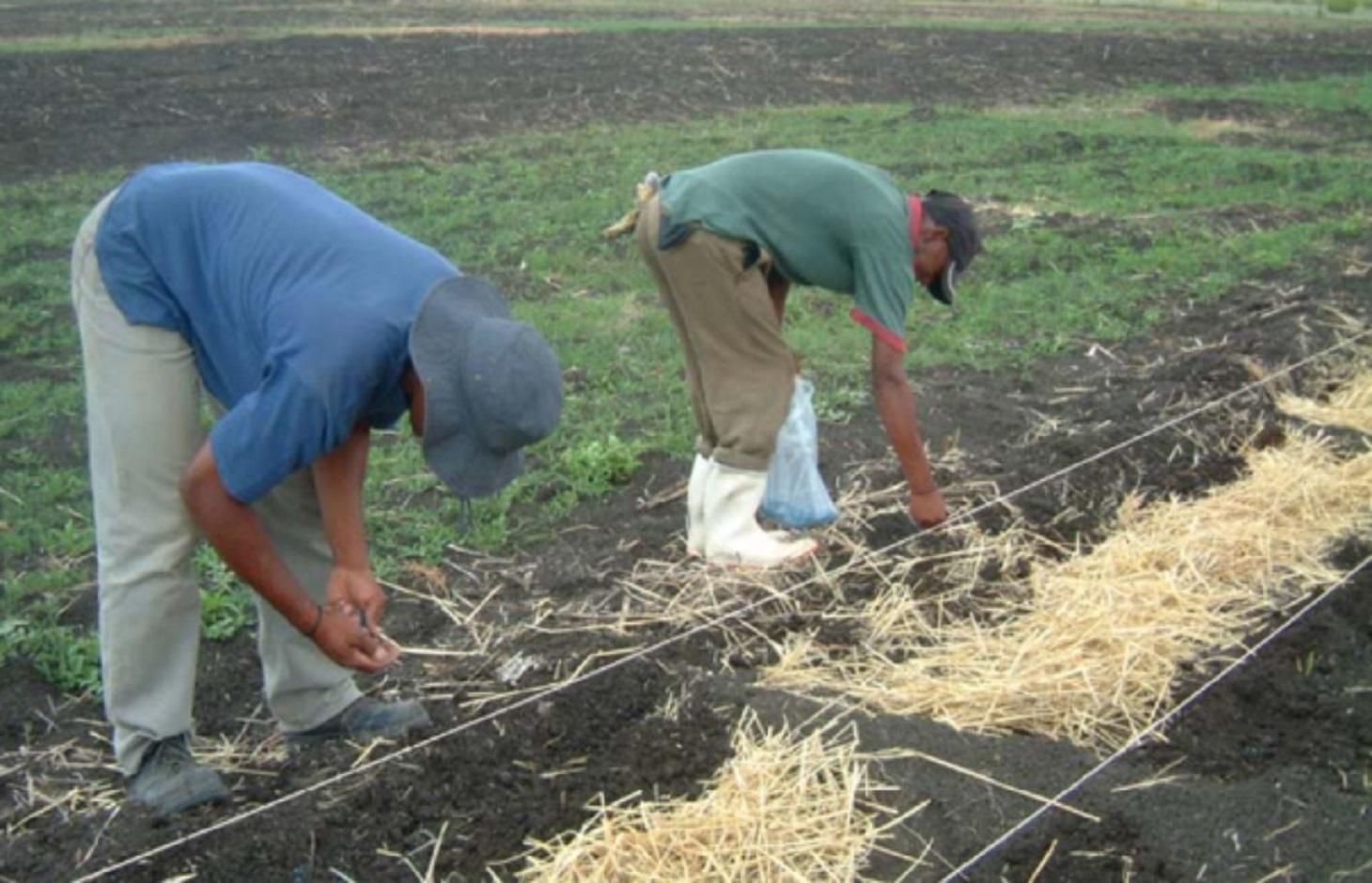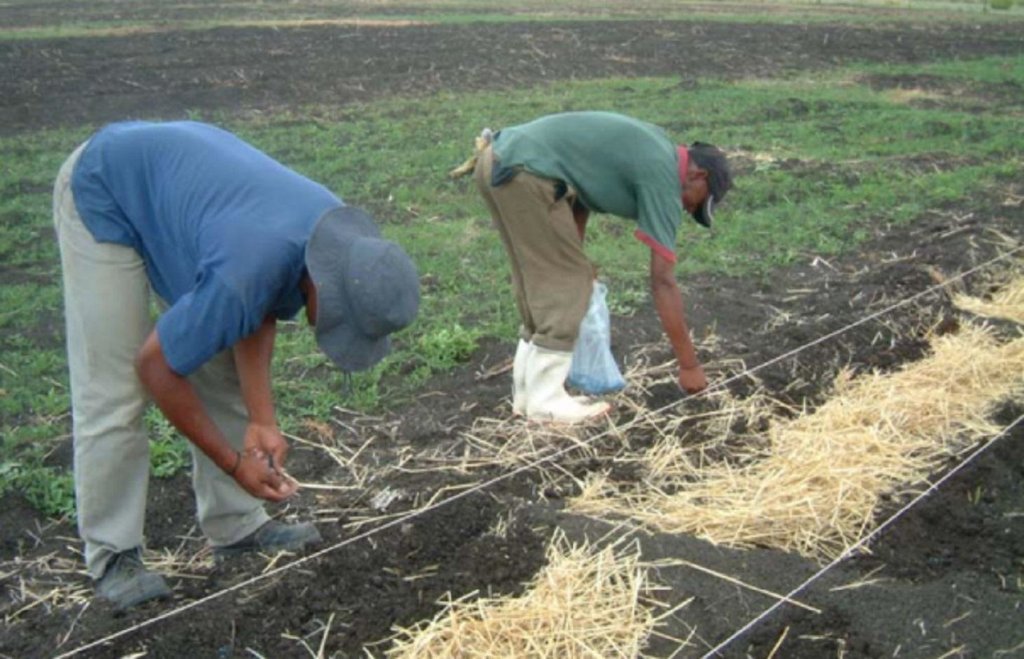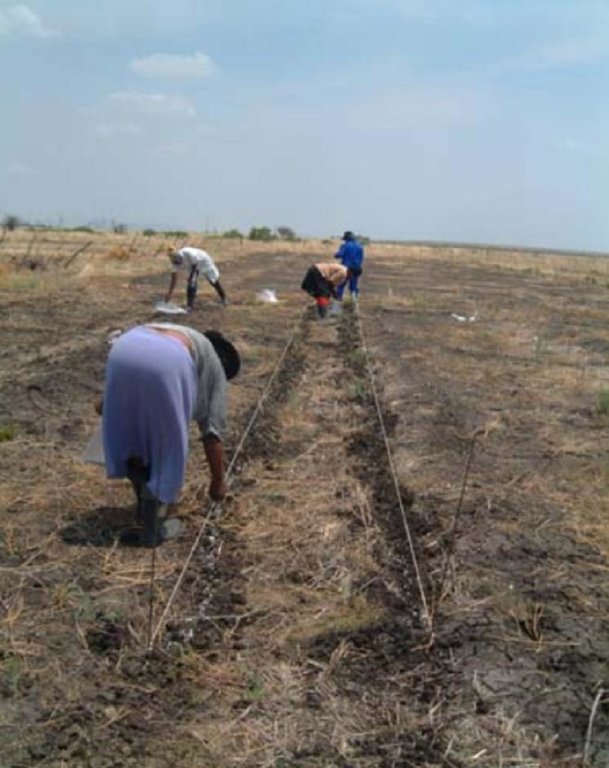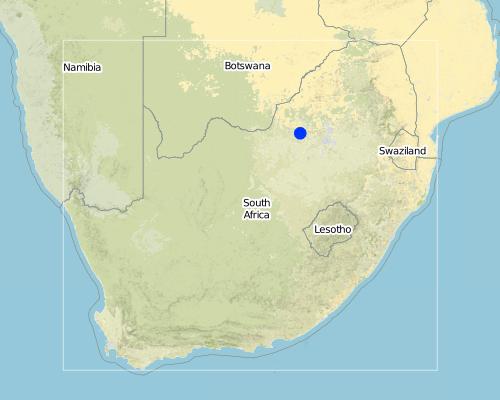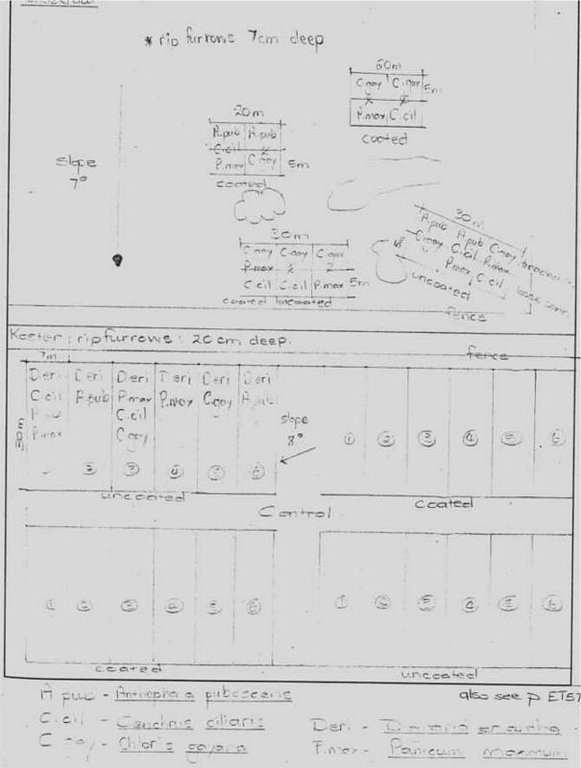Rip-ploughing, oversowing [南非]
- 创建:
- 更新:
- 编制者: Unknown User
- 编辑者: –
- 审查者: David Streiff
Insaai (Afrikaans)
technologies_1372 - 南非
查看章节
全部展开 全部收起1. 一般信息
1.2 参与该技术评估和文件编制的资源人员和机构的联系方式
关键资源人
SLM专业人员:
De Wet Saroné
Hattingh Asterid
1.3 关于使用通过WOCAT记录的数据的条件
(现场)数据是什么时候汇编的?:
25/03/1999
编制者和关键资源人员接受有关使用通过WOCAT记录数据的条件。:
是
2. SLM技术的说明
2.1 技术简介
技术定义:
Ripploughing and oversowing (sodsowing) of extensive grazing land in order to improve productivity of a semi-arid rangeland.
2.2 技术的详细说明
说明:
A pasture characterised by the unpalatable Cymbopogen plurinoides grass species was rip-ploughed to a depth of 20, 15, or 7 cm to uproot the unfavourable grass species.
Coated and uncoated seeds of more palatable grass species were hand sown into the furrows and the soil kicked over the seeds.
Grazing has been excluded for the past four years, giving the sown-in grass species the opportunity to establish and credit the soil seed bank.
The purpose of the technology was threefold: First, the success of rip-ploughing as a restoration technology was researched. Secondly, the suitability of coated or uncoated seeds was established. Thirdly, the suitability of the technology for restoration purposes was researched. This was done in the summer of 1995/96. The frequency and density was measured in the following years up to 1999. The density was measured with a 1 x 1 square meter; and tillers, vegetative and reproductive plants were distinguished.
The purpose of the frequency measurement is to establish the percentage a grass species contributes to the grass community. The density measurement gives the amount of rooted plants in a square meter. Distinction between the life stages indicates the self-sustainability of a population. Seed bank analyses are also added.
2.3 技术照片
2.5 已应用该技术的、本评估所涵盖的国家/地区/地点
国家:
南非
区域/州/省:
North West Province
有关地点的进一步说明:
Madikwe, Koster, Potchefstroom
Map
×2.6 实施日期
如果不知道确切的年份,请说明大概的日期:
- 不到10年前(最近)
2.7 技术介绍
详细说明该技术是如何引入的:
- 在实验/研究期间
注释(项目类型等):
Lennof Reynecke (fellow student) & Klaus Kellner (lecturer)
3. SLM技术的分类
3.1 该技术的主要目的
- 改良生产
3.2 应用该技术的当前土地利用类型

牧场
粗放式放牧场:
- 半游牧/游牧
- 经营牧场
主要动物种类及产品:
Semi-nomadism / pastoralism for Kromspruit and Davidkatnagel
Ranching for Totiuskraal and Koster
注释:
Major land use problems (compiler’s opinion): Overgrazing or rather mismanagement led to i) dominance of the unpalatable grass species at Koster, and ii) bare soil at Totiuskraal, Davidkatnagel and Krompspruit.
Major land use problems (land users’ perception): Erosion/overgrazing making area unsuitable for grazing because of lack of vegetation of appropriate palatability and nutrition.
Semi-nomadism / pastoralism: Kromspruit; Davidkatnagel
Ranching: Totiuskraal; Koster
Grazingland comments: Area closure only followed on incentive of researchers. Koster duplicated area enclosure on own initiative afterwards.
Type of grazing system comments: Area closure only followed on incentive of researchers. Koster duplicated area enclosure on own initiative afterwards.
3.3 有关土地利用的更多信息
每年的生长季节数:
- 1
具体说明:
Longest growing period in days: 180; Longest growing period from month to month: Oct - Mar
3.4 该技术所属的SLM组
- 改良植物品种/动物品种
3.5 技术传播
具体说明该技术的分布:
- 均匀地分布在一个区域
如果该技术均匀地分布在一个区域上,请注明覆盖的大致区域。:
- < 0.1 平方千米(10 公顷)
注释:
Total area covered by the SLM Technology is 0.1 m2.
The localities are not strictly basin, except Kromspruit & Tweefontein. Davidkatnagel has no slope. Totiuskraal lies between the watershed and basin.
3.6 包含该技术的可持续土地管理措施
3.7 该技术强调的主要土地退化类型

土壤水蚀
- Wt:表土流失/地表侵蚀

化学性土壤退化
- Cn:肥力下降和有机质含量下降(非侵蚀所致)

水质恶化
- Ha:干旱化
注释:
Main type of degradation addressed: Wt: loss of topsoil / surface erosion
Secondary types of degradation addressed: Cn: fertility decline and reduced organic matter content, Ha: aridification
3.8 防止、减少或恢复土地退化
具体数量名该技术与土地退化有关的目标:
- 防止土地退化
- 修复/恢复严重退化的土地
注释:
Secondary goals: mitigation / reduction of land degradation
4. 技术规范、实施活动、投入和成本
4.1 该技术的技术图纸
4.2 技术规范/技术图纸说明
Site plan for rip-ploughing and hand sowing of palatable grasses.
North West
Date: 1999
Technical knowledge required for field staff / advisors: low
Technical knowledge required for land users: moderate
Main technical functions: control of concentrated runoff: drain / divert, improvement of ground cover, increase of surface roughness, improvement of topsoil structure (compaction), increase in organic matter, increase of infiltration, increase / maintain water stored in soil
Secondary technical functions: control of raindrop splash, control of dispersed runoff: retain / trap, control of dispersed runoff: impede / retard, control of concentrated runoff: retain / trap, control of concentrated runoff: impede / retard, reduction of slope angle, reduction of slope length, water harvesting / increase water supply, water spreading, sediment retention / trapping, sediment harvesting, reduction in wind speed, increase in soil fertility
Scattered / dispersed
Vegetative material: G : grass
Number of plants per (ha): 100
Spacing between rows / strips / blocks (m): 0.8
Grass species: Anthephora pubescens, Digitaria erlantha, Chloris gayana, Cenchrus ciliaris, Panicum maximum
Slope (which determines the spacing indicated above): 8.00%
If the original slope has changed as a result of the Technology, the slope today is (see figure below): 8.00%
Change of land use type: Area close for plant establishment
Change of land use practices / intensity level: After plant establishment grazing occurs as in 2.4.3.3
4.3 有关投入和成本计算的一般信息
具体说明成本和投入是如何计算的:
- 每个技术区域
注明尺寸和面积单位:
ha
具体说明成本计算所用货币:
- 美元
注明雇用劳工的每日平均工资成本:
8.30
4.4 技术建立活动
| 活动 | 措施类型 | 时间 | |
|---|---|---|---|
| 1. | Seedbed reparation | 植物性的 | Summer |
| 2. | Sowing of seeds | 植物性的 | Summer |
| 3. | Enclosing site | 植物性的 | Summer |
| 4. | Debushing were necessary | 植物性的 | Early Summer |
| 5. | Area enclosure | 管理 | From start for 2 years |
4.5 技术建立所需要的费用和投入
| 对投入进行具体说明 | 单位 | 数量 | 单位成本 | 每项投入的总成本 | 土地使用者承担的成本% | |
|---|---|---|---|---|---|---|
| 劳动力 | Constructing seed beds and | persons/day/ha | 36.0 | 8.3 | 298.8 | |
| 设备 | Machine use | ha | 1.0 | 10.0 | 10.0 | |
| 技术建立所需总成本 | 308.8 | |||||
注释:
Duration of establishment phase: 24 month(s)
4.6 维护/经常性活动
| 活动 | 措施类型 | 时间/频率 | |
|---|---|---|---|
| 1. | Grazing excluded | 植物性的 | /Continuously |
| 2. | Grazing | 植物性的 | Spring (Apr-Sept) /After 2 y for a week; then after regrowth |
| 3. | Rotation grazing | 管理 | Late summer after 2nd year / Once a year for winte |
4.7 维护/经常性活动所需要的费用和投入(每年)
注释:
For Koster, in terms of seeds and tractors; as well as final credit after 3 years measured in R/ large stock unit.
4.8 影响成本的最重要因素
描述影响成本的最决定性因素:
Labour and transport; equipment (gasoline).
5. 自然和人文环境
5.1 气候
年降雨量
- < 250毫米
- 251-500毫米
- 501-750毫米
- 751-1,000毫米
- 1,001-1,500毫米
- 1,501-2,000毫米
- 2,001-3,000毫米
- 3,001-4,000毫米
- > 4,000毫米
有关降雨的规范/注释:
430mm and 520 mm
农业气候带
- 半干旱
5.2 地形
平均坡度:
- 水平(0-2%)
- 缓降(3-5%)
- 平缓(6-10%)
- 滚坡(11-15%)
- 崎岖(16-30%)
- 陡峭(31-60%)
- 非常陡峭(>60%)
地形:
- 高原/平原
- 山脊
- 山坡
- 山地斜坡
- 麓坡
- 谷底
垂直分布带:
- 0-100 m a.s.l.
- 101-500 m a.s.l.
- 501-1,000 m a.s.l.
- 1,001-1,500 m a.s.l.
- 1,501-2,000 m a.s.l.
- 2,001-2,500 m a.s.l.
- 2,501-3,000 m a.s.l.
- 3,001-4,000 m a.s.l.
- > 4,000 m a.s.l.
关于地形的注释和进一步规范:
Landforms: Hill slopes for Totiuskraal, footslopes for Koster and valley floors for Davidkatnagel; Kromspruit
Altitudinal zone: 1,501-2,000 m a.s.l. for Totiuskraal
Slopes on average: Flat for Davidkatnagel, gentle for Kromspruit and moderate for Koster; Totiuskraal
5.3 土壤
平均土层深度:
- 非常浅(0-20厘米)
- 浅(21-50厘米)
- 中等深度(51-80厘米)
- 深(81-120厘米)
- 非常深(> 120厘米)
土壤质地(表土):
- 中粒(壤土、粉土)
表土有机质:
- 中(1-3%)
- 低(<1%)
如有可能,附上完整的土壤描述或具体说明可用的信息,例如土壤类型、土壤酸碱度、阳离子交换能力、氮、盐度等。:
Soil texture: All sites actually; sandy clay loam: the soil is evenly textured but has a high clay content
Soil fertility is very high
Topsoil organic matter: Medium for Koster and poor for Kromspruit, Davidkatnagel and Totiuskraal.
Soil drainage / infiltration: Medium for Koster and poor for Kromspruit, Davidkatnagel and Totiuskraal.
Soil water storage capacity: medium - high
5.6 应用该技术的土地使用者的特征
生产系统的市场定位:
- 生计(自给)
- 商业/市场
非农收入:
- > 收入的50%
说明土地使用者的其他有关特征:
Population density: 10-50 persons/km2
Relative level of wealth: rich, average, very poor
40% of the land users are rich and own 30% of the land (Koster).
40% of the land users are average wealthy and own 30% of the land (Totiuskraal).
20% of the land users are poor and own 40% of the land (Kromspruit; Davidkatnagel).
Off-farm income specification: Farmers have extra-farm occupations for the Totiuskraal area
Market orientation of production system: Subsistence for Kromspruit; Davidkatnagel and commercial for Totiuskraal; Koster
5.7 应用该技术的土地使用者拥有或租用的平均土地面积
- < 0.5 公顷
- 0.5-1 公顷
- 1-2 公顷
- 2-5公顷
- 5-15公顷
- 15-50公顷
- 50-100公顷
- 100-500公顷
- 500-1,000公顷
- 1,000-10,000公顷
- > 10,000公顷
注释:
Not large enough to be economically viable
5.8 土地所有权、土地使用权和水使用权
土地所有权:
- 社区/村庄
- 个人,有命名
土地使用权:
- 社区(有组织)
- 个人
6. 影响和结论性说明
6.1 该技术的现场影响
社会经济效应
生产
饲料生产
注释/具体说明:
Perennial grass species
饲料质量
注释/具体说明:
Perennial grass species
收入和成本
农业收入
注释/具体说明:
Able to carry more livestock in a sustainable way
其它社会经济效应
input constraints
注释/具体说明:
Labourers expect more money
社会文化影响
SLM/土地退化知识
注释/具体说明:
Explained beforehand
冲突缓解
注释/具体说明:
Difference in goal
生态影响
水循环/径流
多余水的排放
土壤
土壤水分
注释/具体说明:
Compared to none treated site
土壤覆盖层
土壤流失
注释/具体说明:
Vegetation cover binds soil
其它生态影响
winter forage
Bush encroachment
注释/具体说明:
Easy establishment
palatability draw animals
注释/具体说明:
If not controlled - overgrazing
6.2 该技术的场外影响已经显现
下游淤积
注释/具体说明:
Vegetation bind soil; denser covering of soil
风力搬运沉积物
注释/具体说明:
Vegetation cover ~100%
6.4 成本效益分析
技术收益与技术建立成本相比如何(从土地使用者的角度看)?
短期回报:
非常积极
长期回报:
非常积极
技术收益与技术维护成本/经常性成本相比如何(从土地使用者的角度看)?
短期回报:
非常积极
长期回报:
非常积极
6.5 技术采用
- 大于 50%
如若可行,进行量化(住户数量和/或覆盖面积):
30 households
在所有采用这项技术的人当中,有多少人是自发地采用该技术,即未获得任何物质奖励/付款?:
- 10-50%
注释:
30 land user families have adopted the Technology
Comments on acceptance with external material support: estimates
25% of land user families have adopted the Technology without any external material support
Comments on spontaneous adoption: estimates
There is a moderate trend towards spontaneous adoption of the Technology
Comments on adoption trend: One land user applied the technology to another part of his farm.
6.7 该技术的优点/长处/机会
| 土地使用者眼中的长处/优势/机会 |
|---|
|
Vegetation cover How can they be sustained / enhanced? Rotational grazing |
| 编制者或其他关键资源人员认为的长处/优势/机会 |
|---|
|
Establishment of perennial grass cover How can they be sustained / enhanced? Grazing management; not graze to seed production stage. |
|
Increase of perennial grass production How can they be sustained / enhanced? Grazing management |
|
Find suitable seed mixtures for different habitats How can they be sustained / enhanced? Literature study on habitat preferences |
|
Seed bed preparation enhance establishment How can they be sustained / enhanced? Know exact depth of sowing of seeds. |
6.8 技术的弱点/缺点/风险及其克服方法
| 编制者或其他关键资源人员认为的弱点/缺点/风险 | 如何克服它们? |
|---|---|
| Implementation in communal areas mostly | Brainstorm on implementation without gasoline needed. |
| Communication with landuser | Contact on monthly basis built friendship |
7. 参考和链接
7.2 参考可用出版物
标题、作者、年份、ISBN:
Veld management in South Africa, Tainton. 1985.
可以从哪里获得?成本如何?
From researcher
链接和模块
全部展开 全部收起链接
无链接
模块
无模块


